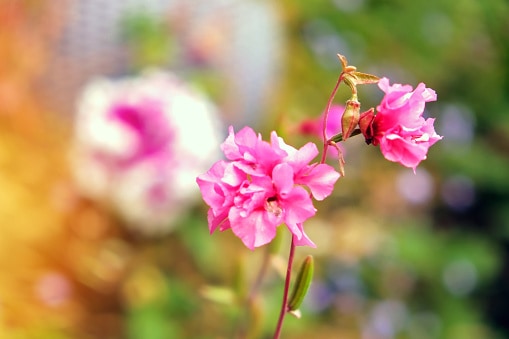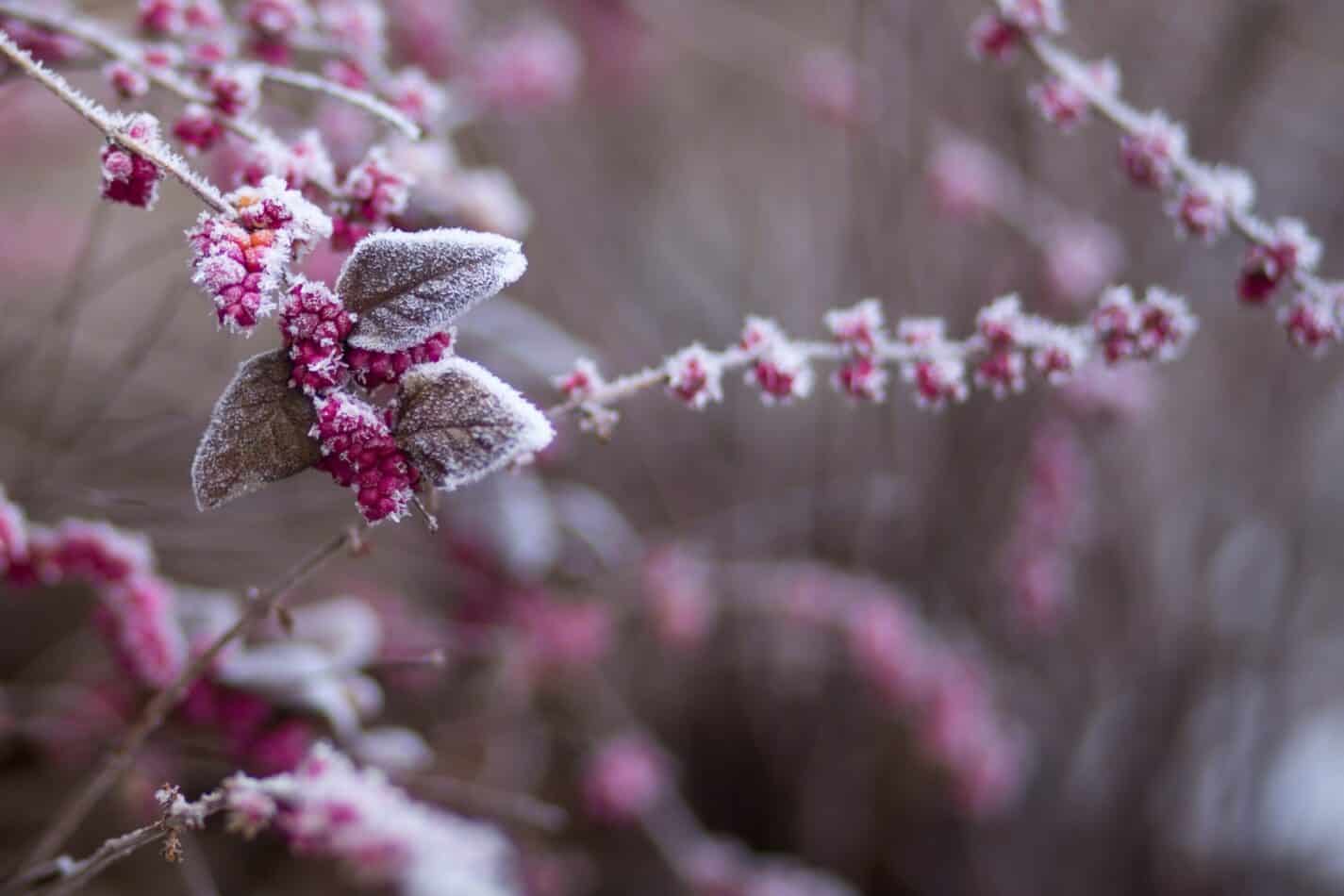Satin Flower (Clarkia Amoena) is also known as Farewell to Spring. It is a native species from coastal Northwestern California, where it blooms from late spring to mid-summer. It is an annual plant with cup-shaped satiny flowers that come in shades of lavender, red, pink, and lilac. The flowers often have a blotch of a contrasting color in the center at the base of each petal. To thrive, they need lots of air circulation and temperatures that don’t drop too low. The plants are suitable for borders and containers, hardy in zones 2 to 11.
Family
Satin Flower is part of the, Onagraceae (Evening Primrose) family. It is a genus of flowering plants that includes five species of annuals and perennials, including Clarkia Amoena.
Plant Type
Satin Flower is an annual plant. This species blooms in late spring to mid-summer with cup-shaped satiny flowers in various lavender, red, pink, and lilac shades. Each petal has a base marked with a blotch of contrasting color.
Mature Size
The Satin Flower’s mature size is 16” – 36” (40 – 90cm) high and 12” – 18” (30 – 45cm) wide.
Sun Exposure
Satin Flowers thrive in full sun exposure (at least 6 hours of direct sunlight a day).
Soil Type
These plants need a soil that is moist, but well-drained. The ideal soil pH is 6.0–7.5.
Soil pH
The soil pH should be between 6–7.5, which is neutral to slightly acidic soil.
Bloom Time
Flowering is typically from late spring until mid-summer.
Flower Color
The flowers come in various shades of lavender, red, pink, and lilac. Each petal is often marked with a blotch of contrasting color at the base.
Hardiness Zones
Satin Flower is hardy in zones 2 to 11.
Native Area
The species is native to coastal Northwestern California.
How to Plant and Grow Satin Flower
When planting Satin Flower outdoors, choose a location that receives at least 6 hours of direct sunlight a day. The best soil type is moist, but well-drained, with a neutral to slightly acidic pH of 6.0–7.5. Planting should take place either during spring or earliest summer, as the plant requires temperatures that do not fall too low to survive. Place the seeds 1-2 inches apart and cover lightly with soil. Water the soil thoroughly after planting. Satin Flower needs good air circulation, thus it is important to space the plants so they are not too close to one another. Place a mulch around the plants to keep the roots cool and moist, especially during times of extreme heat.
For containers, fill them with good quality potting soil, respecting the basic requirements for Satin Flower. Place the container in a spot that gets full sun exposure. Water regularly during the growing season, but don’t overwater the plants – they should be kept moist, but not soaked.
Meaning and Symbolism of Satin Flower
Satin Flower is said to symbolize joy, beauty, and resilience. It is said to attract luck and fortune, and it is believed that when worn, the flower will bring beauty, joy, and love. The flower’s bloom can be compared to the memory of a person’s beauty, innocence, and young age – just like the flower, those moments can never be recaptured.
History, Mythology, and Religious Significance
In the folklore of Native Americans, Satin Flowers were widely used as a medicinal plant. It was used to treat respiratory problems, such as cough and colds, as well as digestive problems.
In some Native American folklore, it was believed that holding a Satin Flower could help increase a woman’s fertility. In Christianity, this flower has a significant association with the Virgin Mary and is seen as a symbol of joy and resurrection.
Flower Varieties and their Defining Characteristics
- The flower variety “Godetia” is a popular variety of Satin Flower. It is a dwarf variety and grows to a mature height of 8 – 15” (20 – 38cm). This variety features white, pink, or red flowers.
- The Clarke’s Clarkia variation has fewer petals than other varieties, but the petals are bigger and more “fringy”. The color of these flowers varies from white to shades of purple, pink, and red.
- The Pink Ribbon variety features pink flowers on 16-20” tall (40-50cm) stems with doubly fringed petals which are generally one inch in diameter.
How to Pot and Repot
When potting a Satin Flower, it is best to use a pot that is at least 8-10” (20-25cm) in diameter. Make sure to use a pot that is made of breathable material and comes with good drainage. When planting a Satin Flower in a pot, use potting mix and place the plant in the center. Lightly tamp the surface and then water the pot. Place your container in a spot that receives a few hours of direct sunlight a day.
If the Satin Flower has been in the same pot for a long time, repot it in late winter. Carefully take out the plants from the pot and use scissors to cut away damaged roots. Then fill the new pot with new potting mix, place the plant in the center, and add more potting mix around it. Once it is done, water the pot and place it in a sunny spot.
How to Prune
Pruning Satin Flower is easy and doesn’t require any specialized tools. In the spring, prune off any dead or damaged stems. In the late summer and fall, cut back the top of the stems for a better shape and to increase blooming. It is also important to pinch off the dying flowers in order to promote new blooms.
How to Propagate
Satin Flower is easily propagated by seed. Collect the ripe seed capsules in late summer. Plant the harvested seeds in late winter and cover lightly with potting mix. Germination is typically 2-3 weeks and the seedlings will bloom in late spring.
Common Pests and Diseases
Satin Flower is not prone to pests or diseases, but they can be occasionally attacked by aphids or white flies. To prevent disease and pest damage, the plant should be kept in an area with good air circulation and free from too much moisture.
Three Frequently Asked Questions About Clarkia Amoena
Q: How tall is Satin Flower?
A: The mature size of Satin Flower can range from 16” – 36” (40 – 90cm) high and 12” – 18” (30 – 45cm) wide.
Q: When does Satin Flower bloom?
A: Flowering is typically from late spring until mid-summer.
Q: What type of soil does Satin Flower require?
A: Satin Flower needs a soil that is moist, but well-drained. The ideal soil pH is 6.0–7.5.
Fact Sheet
| Satin Flower | Clarkia Amoena |
|---|---|
| Family | Onagraceae (Evening Primrose) |
| Plant Type | Annual |
| Mature Size | 16” – 36” (40 – 90cm) high and 12” – 18” (30 – 45cm) wide. |
| Sun Exposure | Full Sun |
| Soil Type | Moist, but well-drained soil. Neutral to slightly acidic soil pH of 6.0–7.5. |
| Bloom Time | Late spring to mid-summer. |
| Flower Color | Lavender, red, pink, and lilac. |
| Hardiness Zones | 2 to 11. |
| Native Area | Northwestern California. |
What we love from Amazon this week
Buy these wonderful flowers directly from Amazon:















